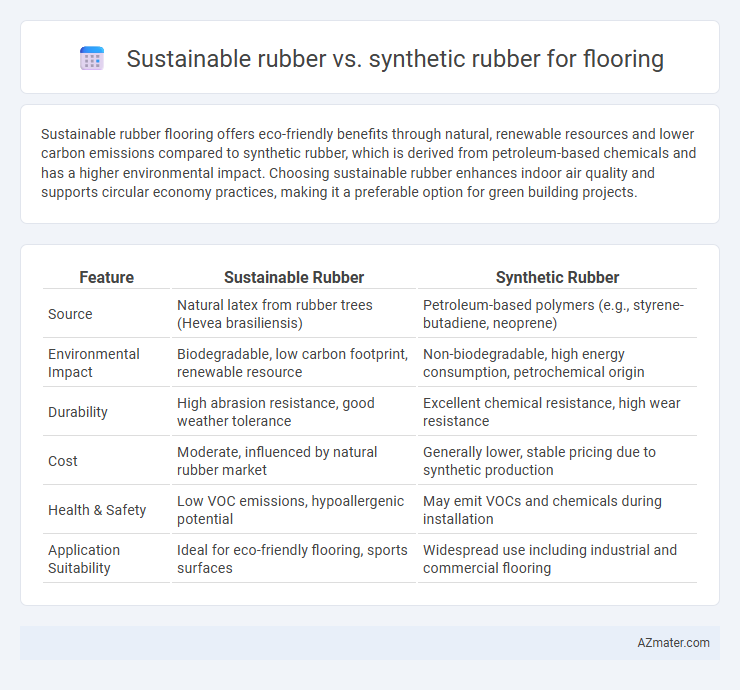Sustainable rubber flooring offers eco-friendly benefits through natural, renewable resources and lower carbon emissions compared to synthetic rubber, which is derived from petroleum-based chemicals and has a higher environmental impact. Choosing sustainable rubber enhances indoor air quality and supports circular economy practices, making it a preferable option for green building projects.
Table of Comparison
| Feature | Sustainable Rubber | Synthetic Rubber |
|---|---|---|
| Source | Natural latex from rubber trees (Hevea brasiliensis) | Petroleum-based polymers (e.g., styrene-butadiene, neoprene) |
| Environmental Impact | Biodegradable, low carbon footprint, renewable resource | Non-biodegradable, high energy consumption, petrochemical origin |
| Durability | High abrasion resistance, good weather tolerance | Excellent chemical resistance, high wear resistance |
| Cost | Moderate, influenced by natural rubber market | Generally lower, stable pricing due to synthetic production |
| Health & Safety | Low VOC emissions, hypoallergenic potential | May emit VOCs and chemicals during installation |
| Application Suitability | Ideal for eco-friendly flooring, sports surfaces | Widespread use including industrial and commercial flooring |
Introduction to Rubber Flooring Options
Sustainable rubber flooring, derived from natural sources like recycled tires and renewable rubber trees, offers environmentally friendly benefits including biodegradability and lower carbon footprint compared to synthetic rubber. Synthetic rubber, typically made from petroleum-based materials such as styrene-butadiene rubber (SBR), provides durability and resistance to chemicals but contributes to environmental pollution during production and disposal. Choosing between sustainable and synthetic rubber flooring depends on balancing eco-conscious material sourcing with specific performance requirements for commercial or residential spaces.
What is Sustainable (Natural) Rubber?
Sustainable rubber, also known as natural rubber, is harvested from rubber trees (Hevea brasiliensis) using environmentally friendly methods that promote biodiversity and reduce deforestation. It offers renewable, biodegradable properties that minimize ecological impact compared to petroleum-based synthetic rubber commonly used in flooring. Natural rubber flooring provides durability, elasticity, and antimicrobial properties while supporting sustainable agricultural practices and reducing carbon footprint.
Understanding Synthetic Rubber
Synthetic rubber, derived primarily from petroleum-based monomers such as styrene and butadiene, offers high durability and resistance to heat, abrasion, and chemicals, making it a popular choice for commercial and industrial flooring. Unlike natural rubber, synthetic variants provide consistent quality and performance under varying environmental conditions without relying on agricultural resources. However, synthetic rubber's environmental impact, including non-renewable resource consumption and limited biodegradability, contrasts sharply with sustainable rubber options that emphasize eco-friendly sourcing and recyclability.
Environmental Impact: Sustainable vs Synthetic
Sustainable rubber flooring, derived from natural latex harvested from rubber trees, significantly reduces carbon emissions and energy consumption compared to synthetic rubber made from petrochemicals. Natural rubber is biodegradable and supports biodiversity by promoting responsible forestry practices, whereas synthetic rubber contributes to pollution and relies on non-renewable fossil fuels. The environmental footprint of sustainable rubber is minimized through renewable sourcing, lower greenhouse gas emissions, and enhanced end-of-life recyclability.
Durability and Performance Comparison
Sustainable rubber flooring, derived from natural sources like Hevea brasiliensis, offers superior elasticity and resilience, enhancing durability under heavy foot traffic and resisting wear over time. Synthetic rubber flooring, typically made from styrene-butadiene or nitrile rubber, provides consistent performance with high abrasion resistance and excellent chemical stability but may degrade faster under UV exposure. Both materials ensure strong grip and shock absorption; however, sustainable rubber excels in eco-friendliness and aging resistance, making it a preferred choice for long-term flooring solutions.
Health and Safety Considerations
Sustainable rubber flooring, derived from natural latex or recycled materials, offers lower VOC emissions and reduced exposure to toxic chemicals compared to synthetic rubber, enhancing indoor air quality and minimizing respiratory risks. Synthetic rubber flooring often contains additives like plasticizers and stabilizers that can off-gas harmful substances, posing potential health hazards to occupants over prolonged exposure. Choosing sustainable rubber flooring supports safer environments by ensuring non-toxic, hypoallergenic properties and better resistance to microbial growth, contributing to overall health and safety.
Cost Analysis: Initial and Long-Term
Sustainable rubber flooring typically incurs higher initial costs due to eco-friendly sourcing and processing methods, but offers lower maintenance expenses and longer lifespan, resulting in better long-term savings. Synthetic rubber flooring presents a lower upfront price yet often demands more frequent replacements and repairs, increasing total lifecycle costs. Evaluating the cost analysis reveals sustainable rubber's potential for enhanced economic efficiency driven by durability and environmental benefits.
Installation and Maintenance Differences
Sustainable rubber flooring, made from natural latex and recycled materials, offers easier installation with less specialized equipment compared to synthetic rubber, which often requires adhesive curing and precise temperature control. Maintenance of sustainable rubber floors involves simple cleaning with eco-friendly products, benefiting from natural antimicrobial properties, whereas synthetic rubber demands regular chemical treatments to prevent wear and discoloration. Both types provide durability, but sustainable rubber's biodegradability and lower environmental impact make it preferable for green building projects focused on long-term sustainability.
Aesthetics and Design Versatility
Sustainable rubber flooring offers rich, natural textures and varied color options that enhance aesthetic appeal while promoting eco-friendly design principles. Synthetic rubber provides consistent coloration and uniform surface finishes, enabling precise patterning and customization for modern, high-traffic spaces. Both materials support versatile design applications, but sustainable rubber integrates organic visual elements better suited for environmentally conscious interiors.
Choosing the Right Rubber Flooring for Your Needs
Sustainable rubber flooring, made from natural latex or recycled materials, offers eco-friendly benefits such as biodegradability and lower carbon footprint compared to synthetic rubber, which is petroleum-based and less environmentally friendly. When choosing rubber flooring, consider factors like durability, slip resistance, installation environment, and maintenance requirements; sustainable rubber excels in indoor air quality and sustainability, while synthetic rubber provides superior chemical resistance and abrasion durability for high-traffic commercial spaces. Selecting the right rubber flooring depends on balancing environmental impact with performance needs, prioritizing sustainable options for green building certifications or synthetic alternatives for heavy-duty applications.

Infographic: Sustainable rubber vs Synthetic rubber for Flooring
 azmater.com
azmater.com